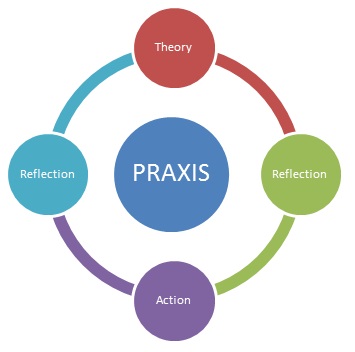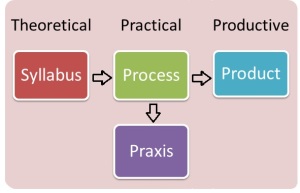Praxis
August 4, 2013 6 Comments
“Thinkers think and doers do. But until the thinkers do and the doers think, progress will be just another word in the already overburdened vocabulary of the talkers who talk.”
Anonymous
This quotation is a reminder that there can sometimes be a gap between theory and practice in adult and community learning. Of course there are theorists who are teachers – and teachers who are theorists – but theory is sometimes remote from practice, where there is a rich experience of tutors intuitively developing creative and successful strategies for teaching, learning and assessment, often working collaboratively. It’s interesting that Twitter and social media are providing means to open up exchanges of ideas and debate, prompting wider professional dialogue on these matters.
Theory and practice come together in the concept of ‘praxis’.
What is praxis in education?
A simple explanation is that praxis is a cycle of theory and purposeful action that incorporates reflection. It helps us to analyse our efforts so that we can develop and improve our thinking, doing and effectiveness as educators.
There are other interpretations and this doesn’t capture the additional elements of informed moral commitment and critical thinking that are commonly associated with praxis. Paulo Freire’s definition of praxis in Pedagogy of the Oppressed was, “reflection and action upon the world in order to transform it.” Praxis is reflective, active, creative, contextual and has social purpose.
Centuries ago the ancient Greek philosopher Aristotle categorised three disciplines of knowledge: the theoretical, the productive and the practical and some educators see praxis as one of four ways of approaching curriculum theory and practice, based on these three disciplines:
- The syllabus approach can be seen as transmitting a body of knowledge .
- The product approach assumes an attempt for students to achieve specified outcomes.
- Learning to learn is the main focus of a process driven approach.
- Praxis can be seen as an extension of the process approach, where the curriculum is put together through planning, acting and evaluating as in the cycle described above.
Is this model too simplistic? Are the four approaches mutually exclusive?
These are very basic and introductory interpretations of praxis. Although they refer to education as being contextualised, they can imply that the relationship between tutors and students is not shaped or constrained by policy and, in many organisations, by management and governance decisions.
What issues does this raise?
Some organisations are taking imaginative and very distinctive approaches. For example, Louise Mycroft (@TeachNorthern on Twitter) and others have developed a ‘Community of Praxis’ based on Northern College’s teacher education programmes.
As ever, I’d appreciate comments, development of arguments, disagreements, other ideas or links. There is a great deal of expertise on this subject and many people who can add deeper (or different?) perspectives about praxis in education.
What do you think?



This reminds me of the mythical Frenchman who is supposed to have asked, “That’s all very well in practice, but how does it work in theory?” At the branch level we offer courses that some will sign up for. They might join to learn how to use a computer or because they would like to attend a class on art history or music appreciation. If asked I think they would be likely to mention pleasure and enjoyment. Let’s try it. But from our point of view the problem lies in finding courses we can put on to meet the latent demand: I get asked why we don’t offer more. That’s our starting point.
Thanks for commenting Mike and for adding a branch perspective. You’ve raised an important issue.
Our volunteer-led branches who organise courses at local levels are a vital part of the WEA, often forming local governance and working hard to organise and promote courses and to engage and support potential students – amongst other activities.
As you say, understanding latent demand, planning courses and engaging students in their communities are the starting points – where our network of branches, organisers and partner organisations play key roles.
Once they have started courses, we have to think about how we inspire and challenge students, how they know about their progress, what difference their learning is making to them and what they can do next.
Then, of course, we have to act on that thinking.
My comment came out grouchier than I intended, and I’m sorry about this. But yes, I think that there is a disconnect between the WEA’s vision and that of the branches. Trouble is that there isn’t a single branch perspective but rather almost as many perspectives as there are branches. Underlying it all, however, the WEA sees the branches as a means to an end whereas the branches see their Region as a means to an end. I believe the WEA should try to exploit its branches more. There’s a lot I could say about that, but I’ll pause there….
Mike, I would be interested in discussing your ideas for exploiting the branches more – both through my marketing team hat and volunteer development hat! I think branches take great pride in the inspirational teaching that is common throughout the Cultural Studies programme and their relationship with tutors contributes significantly at the interface of the syllabus and product approaches. One of the joys of the WEA is the breadth of perspectives – but anything we can do to channel that creative energy into increasing the numbers of students who come to learn for pleasure, enjoyment and indeed challenge is to be welcomed
Thanks again Mike. I did invite debate and even disagreement so I’m pleased that you’ve commented and come back again. We wouldn’t need a Constitution and democratic structure in the WEA if everyone agreed on everything.
Whatever our views or roles, I’d argue that the WEA’s ends are about inspirational learning.
I see that Pearl Ryall has offered a discussion from a marketing and volunteering perspective and I support any developments that promote closer working relationships between branches, volunteers, students and staff. Please let me know if you’d like a further chat about any of these issues (email awalker@wea.org.uk)
Thanks Pearl.